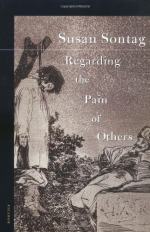
|
| Name: _________________________ | Period: ___________________ |
This test consists of 15 multiple choice questions and 5 short answer questions.
Multiple Choice Questions
1. Sontag criticizes American portrayals of U.S. military strategy, saying that war museums do not emphasize which of the following?
(a) U.S. use of disproportionate fire power.
(b) War crimes committed by United States officers.
(c) U.S. defeat in battle.
(d) The victims of U.S. military force.
2. According to Sontag, the idea that less people are reacting to news of atrocity is probably which of the following?
(a) Painfully true.
(b) Not true.
(c) Regrettably true.
(d) Somewhat true.
3. Sontag cites one of her earlier books published in 1977. Which of the following is it?
(a) "Against Interpretation."
(b) "Reborn."
(c) "Illness as Metaphor and AIDS and Its Metaphors."
(d) "On Photography."
4. _______ is a classic use for the camera.
(a) Beautifying.
(b) Uglifying.
(c) Simplifying.
(d) Complicating.
5. According to Sontag, a person who fails to recognize that people are capable of committing atrocities has failed to achieve which of the following?
(a) Intellectual development.
(b) Psychological or moral adulthood.
(c) Emotional security.
(d) Realistic perspective.
6. According to Sontag, Wall's photograph may have been an updated version of which infamous image from the First World War?
(a) Friedrich's "War against War!"
(b) Gance's "J'accuse."
(c) Gardner's "Photographic Sketch Book of the War."
(d) Goya's "Distasters of War."
7. Sontag insists that images may be ineffective; however, they do serve one basic and significant function. What is that function?
(a) Images remind us that humans are capable of causing great pain.
(b) Images provide moral education.
(c) Images provide representation for the victims, no matter how flawed.
(d) Images inoculate us to the effects of atrocity.
8. Which of the following thinkers argued that people take "no small" delight in witnessing the suffering of others?
(a) Plato.
(b) Aristotle.
(c) Renee Descartes.
(d) Edmund Burke.
9. Sontag claims that the model for public space in modern society is which of the following?
(a) The mega-store.
(b) The memorial.
(c) The debate hall.
(d) The classroom.
10. Sontag suggests that to make peace is to do which of the following?
(a) Understand.
(b) Remember.
(c) Forget.
(d) Forgive.
11. Discussing the common person's ability to feel sympathy, Sontag argues which of the following?
(a) People will automatically feel sympathy for victims of atrocity.
(b) People will instinctually distance themselves from suffering.
(c) People will do anything to keep from being moved by what they see.
(d) People will naturally feel empathy, but will quickly distance themselves because society has programmed them to avoid involvement.
12. Sontag argues that which of the following effects keeps the television viewer's attention "light", "mobile" and fairly "indifferent" to the images on the screen?
(a) Media coverage.
(b) Overload.
(c) Image-glut.
(d) Advertising.
13. Contemporary society, at the time Sontag wrote the book, unanimously witnessed a rise of which of the following in the media?
(a) War protest.
(b) Violence and sadism.
(c) Sadism and sexuality.
(d) Violence and sexuality.
14. Which of the following best describes the "CNN effect" as discussed by Sontag?
(a) Extensive media coverage directly affected local politics.
(b) Distorted media coverage misleads the public.
(c) Media coverage lead to the sentiment that something must be done.
(d) Outrageous media coverage lead to a backlash against the media.
15. Sontag claims that Bataille could see extreme pain as a form of __________.
(a) Deification.
(b) Erotic pleasure.
(c) Sadomasochism.
(d) Transfiguration.
Short Answer Questions
1. Sontag suggests that it is still possible to "feel the pulse of Christian iconography" in much war photography. Which famous work of art does she suggest can be seen in W. Eugene Smith's photograph of the woman in Minamata cradling her child?
2. According to Sontag, if one feels sympathy for the victims of suffering, it helps ensure that one cannot be ___________.
3. Sontag suggests that Plato anticipated which of the following psychological models?
4. Sontag begins Chapter 9 with which of the following assertions?
5. Sebastiao Salgado's work called "Migrations: Humanity in Transition" was often criticized as being:
|
This section contains 666 words (approx. 3 pages at 300 words per page) |

|




